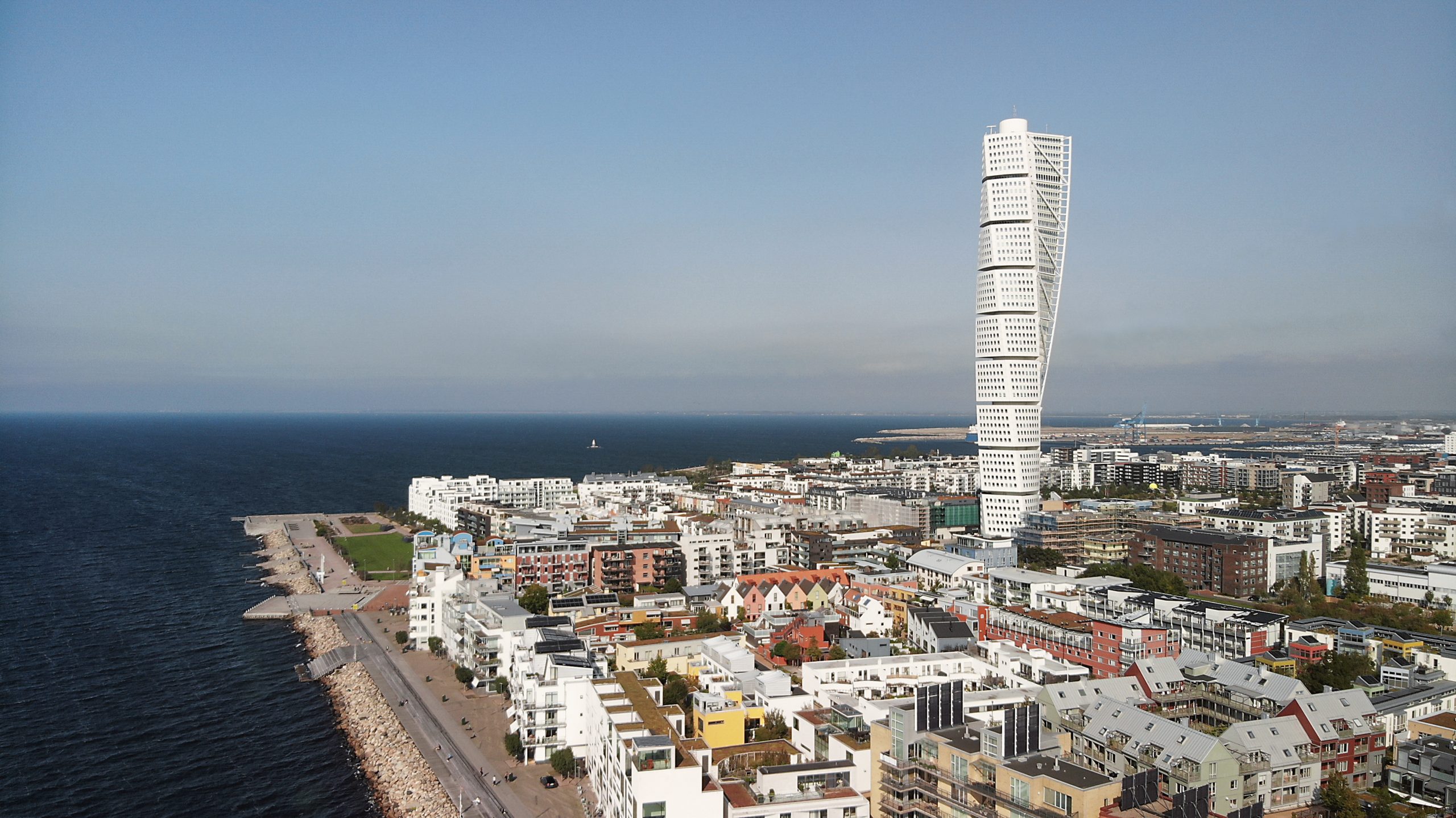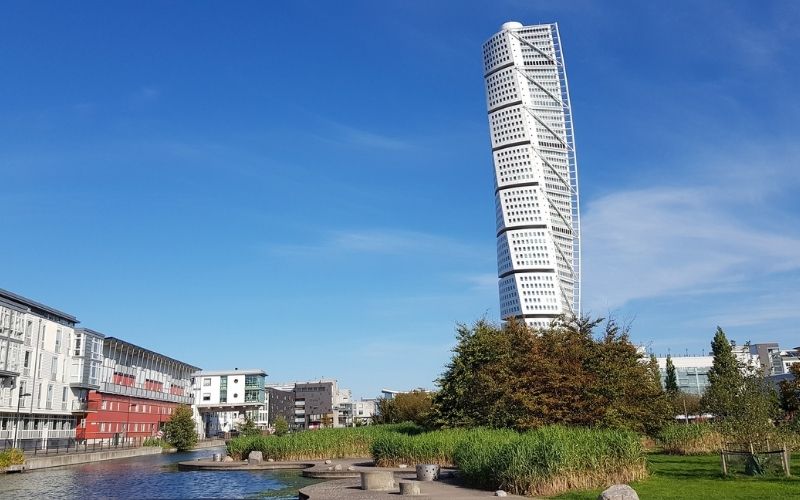Turning Torso, Malmö: elevator modernization in an icon of architecture
Over 15 years after its original construction, the Turning Torso in Malmö, Sweden, remains a highly influential building as the world’s first twisting tower. We take a look at this iconic building!

An icon of modern architecture
The Turning Torso, a twisting skyscraper in Malmö, Sweden, is a multiple award-winning building designed by Spanish architect, structural engineer, sculptor and painter Santiago Calatrava. Nearly every structure designed by Calatrava is a work of art – a sculpture on the grand scale. Whether it’s one of his signature suspension bridges, a museum, or a skyscraper – every structure designed by him is worthy of study and admiration. “I have tried to get close to the frontier between architecture and sculpture and to understand architecture as an art”, Calatrava said.
The Turning Torso in Malmö is no different. In fact, its design was inspired by a sculpture of a twisting human torso made by Santiago Calatrava himself. It’s no surprise that he describes his approach to architecture as more of an art than a science. The building started a trend of twisting towers around the world.
But even icons of modern architecture need a little modernization now and then. This is where TK Elevator stepped in to make the elevators not only look better, but to make them more efficient and longer-lasting – while integrating them seamlessly into the building without disrupting the original concept of the interior design.

Turning Torso, Malmö, Sweden

Turning Torso, Malmö, Sweden

Turning Torso, Malmö, Sweden
The Turning Torso, as mentioned, is an abstract representation of the human body with nine cubes twisting elegantly around a straight structural core. A steel frame runs along the corners of the cubes, creating an impression of a spine and ribs. Each cube is composed of five floors, offering approximately 2,000 sqm of space. Since its completion in 2005, the Turning Torso has remained – at 190 meters in height – the tallest residential building in Sweden and the second tallest residential building in Europe.
The building is credited as the initial spark that led to a long succession of twisting towers around the world. In fact, that is one of the reasons that the Council on Tall Buildings and Urban Habitat (CTBUH) included it on its list of the 50 Most Influential Tall Buildings of the Last 50 Years: “It is widely considered the first ‘twisting’ skyscraper, inspiring countless other designs. Its exoskeletal frame symbolically references the shipyard gantries of Malmö’s past, but points toward a progressive future, and has become a symbol of Sweden, featuring on a page of its citizens’ passports.”
This ongoing trend of the twist even earned it the 10 Year Award from CTBUH in 2015. According to Vincent Tse, CTBUH Trustee, the “iconic, astonishing and inspirational” building has gone on to inspire more than 30 other towers that twist upward. “Looking back at innovations over the past decade, few have had the lasting power and influence of the Turning Torso.”
Timothy Johnson, Partner, NBBJ, and former Chairman and Trustee, Council on Tall Buildings and Urban Habitat added: “The Turning Torso is one of those superb examples that went beyond the creation of a signature tower and helped shape an entirely new and invigorating urban fabric.”

Task: digitally revamp three residential elevators
TK Elevator was tasked with the modernization and digitalization of the residential elevators to improve the user experience with smart destination control. But there was one small catch: the tenants were not to be disturbed in the process.
According to the team that worked on the project: “The Turning Torso has five elevators in total. Two are reserved for the office space located in the first two ‘cubes’ of the tower, and they have their own separate entrance. We worked on the three residential elevators – the only ones that go all the way up. To make it easier for the residents, we only shut off one elevator at a time. However, these elevators operate in a group, so it was not always easy to take out the units. Doing so increases the pressure on the remaining units in operation. Still, we wanted to keep the users in focus and make sure that they were not overly inconvenienced over the entire modernization process.”
Benefits of elevator modernization in the Turning Torso
As can be seen in the before-and-after pictures below, the elevators received a more modern and sleek appearance, both inside and out. They are also much more efficient and safer thanks to AGILE – Destination Control, TK Elevator’s destination dispatch system. That system also meant that all the floor buttons inside the elevators could be covered up for a more streamlined appearance, although they remain accessible to rescue workers below a panel. According to the project team: “We only have three buttons in the elevators: open, close, and emergency call.”
But how do tenants get to where they want to go if there are no call buttons? That’s where AGILE – Destination Control comes in.

Elevator modernization at Turning Torso: before and after

Elevator modernization at Turning Torso: before and after

Elevator modernization at Turning Torso: before and after
Elevator enhancers take elevators to the next level
The elevators in the Turning Torso are already more than 15 years old, but they now feature some of the most modern elevator digital technology: a destination dispatch system. The project team explains: “With AGILE – Destination Control, the users will experience shorter waiting times. When you get to the elevator lobby, you choose your destination floor on a touch screen, and AGILE calculates which elevator will make your trip the fastest. Then, on the touch screen, you see which elevator you should take. Once inside the elevator, there are no destination buttons, but the screen displays the stop to come.”
Gone are the days of long waits, and tenants will never be greeted by an elevator that is already filled to capacity. Those who have experienced the upgrade to digital technology, like the change from call buttons to destination dispatch can understand why these systems are often referred to as “elevator enhancers”.
This relatively easy upgrade can deliver up to 30% more traffic handling capacity, 25% less elevator travel time, and it completely avoids overcrowding in elevators. Users can even enjoy one-touch access to their destinations, and security protocols can regulate who is allowed to go where. The touchscreens can even be programmed to offer personalized messages. AGILE is a comprehensive portfolio of digital solutions designed to transform personal mobility and create the ultimate mobility experience.
Modernize & upgrade or remove & replace?
One way to reduce the carbon footprint of buildings – as well as to reduce the waste they generate – is to follow the ethos of “maintain, modernize, and extend the service life”. Particularly when it comes to major technical components of buildings like elevators, extending the service life of existing elevators is – in most cases – the most environmentally friendly choice, because modernization generates less waste than replacement.
Also, even older buildings deserve modernization rather than demolition. And that’s not just because it’s the greener choice (which is already reason enough). These buildings are part of the culture of our cities. That´s why adaptive reuse should be always taken into consideration to preserve a city’s architectural heritage.
In Malmö: an aesthetically pleasing and efficient result
Although the elevators in the Turning Torso are over 15 years old, their service lives have been at least doubled. According to the project team: “After commissioning the modernized elevators, we counted more than 60,000 starts per elevator in the first month without a single error. Since TK Elevator offers high quality products, we are sure that the elevators will last longer than another 15 years.”
As digitalization increases, more and more elevators will be upgraded to deliver improved efficiency and maintenance with enhanced digitized services.


